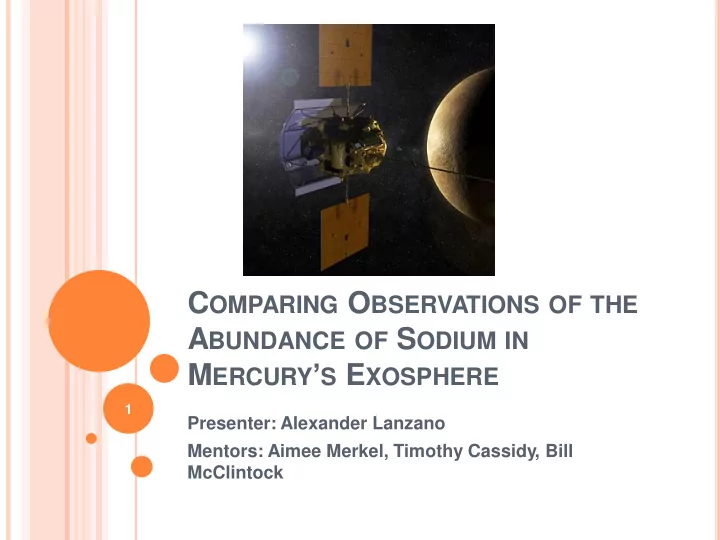

C OMPARING O BSERVATIONS OF THE A BUNDANCE OF S ODIUM IN M ERCURY ’ S E XOSPHERE 1 Presenter: Alexander Lanzano Mentors: Aimee Merkel, Timothy Cassidy, Bill McClintock
M OTIVATION Mercury is highly vulnerable to the Sun Its exosphere is most likely dependent on the amount of radiation the planet receives MESSENGER is one of the first satellites to obtain data about the exosphere from orbit We can compare this new data to ground based data to see if there are any corresponding trends Discovering how the exosphere is influenced by the Sun can give us an insight into: The chemical composition of Mercury How the planet might have formed How our Solar System might have formed 2 What other planets might be like in other system at similar distances as Mercury is from the Sun
O UTLINE Background on Mercury and the solar influence on its exosphere Variables of interest Observations from Earth Observations from MESSENGER Comparison of the two data sets Observed trends 3
M ERCURY General Facts Smallest planet, 6% Earth 1 year = 88 Earth days Mercury 1 day = 176 Earth days Highly eccentric orbit Magnetic field present Virtually no atmosphere Highly influenced by the Sun High energy particle collisions Radiation pressure 4 Earth’s moon
M ERCURY ’ S A TMOSPHERE No sustainable atmosphere Thin Exosphere H, He, O, Ca, Mg, K Na Resembles comet tail Source of Exosphere Sputtering PSD Thermal Evaporation 5 Impact evaporation
Sprague et al. 1997 Photon Emission vs Spectrum Wavelength D ETERMINE S OLAR I NFLUENCE D2 BY V ARIATION IN OBSERVED N A D1 Counts Search for increase in Na density: D1 and D2 (yellow) spectrum 580 nm How does it change with respect to: Wavelength (angstroms) Time of Day Change of season 6
G ROUND B ASED O BSERVATION M ETHOD y N N x S Observation Slit 7
S PRAGUE ET AL . O BSERVATIONS Sprague et al. 1997 Sprague et al.’s conclusions: Na column density varies with local time Did not account for True Anomaly 8
C OMPILING THE D ATA Sprague et al. 1997 9
D ETERMINE L OCAL T IME Sub-Solar Point Mercury X Sub-Earth Point 10 Y
Column Density (cm -2 ) 6:00-8:00 8:00-11:00 11:00-13:00 13:00-15:00 15:00-18:00 11 Local Time (hrs)
N EW P ARAMETERS OF I NTEREST True Anomaly Used to determine seasonal variability of Na density Mercury True Anomaly θ Closest Point to the Sun Sun 12
Column Density (cm -2 ) 13
T HE MESSENGER M ISSION Takes vertical profile scans of Mercury’s exosphere Uses UVVS Records Na Column density for: Local time Seasonal variability 8 Mercury years of data (2 Earth years) 14
Column Density (cm -2 ) 15
C OMPETING F ACTORS Sunlight Exposure vs Radiation Pressure Greater photon intensity closer to the sunlight means more Na vaporization, but… Being closer to the sun means more radiation pressure that disperses the exosphere Low Intensity Low Pressure True Anomaly=180 o High Intensity High Pressure True Anomaly= 0 o 16
17
18
19
20
21
22
C ONCLUSIONS Increases in Na density depends on: True Anomaly Local time Both ground based and MESSENGER data are same order of magnitude Overall: Data show similar trends! 23
F UTURE W ORK Conduct an analysis of outliers in Sprague data Attempt to account for difference in D1 an D2 spectra Compare to other ground based data that used different observation techniques Potter et al. 24
R EFERENCES AND IMAGES Image slide 1: http://nssdc.gsfc.nasa.gov/image/spacecraft/messenger.jpg Images slide 4: http://history.nasa.gov/EP-177/i2-6.jpg http://www.8planets.co.uk/wp- content/themes/8planets/images/moon_surface_apollo_11_lg.jpg http://undsci.berkeley.edu/images/us101/mercury.gif Image slide 5: http://www.windows2universe.org/mercury/Atmosphere/mercury_exosphere_ sodium_oct_2008_sm.jpg Image slide 5: http://upload.wikimedia.org/wikipedia/commons/2/2f/Fraunhofer_lines.svg Plot slide 5: Sprauge, Kozlowski, Hunten. Distribution and Abundance of Sodium in Mercury’s Atmosphere, 1985 -1988. 1997. Icarus 129, page 512 25
R EFERENCES AND I MAGES C ONT . Image slide 8: Sprauge, Kozlowski, Hunten. Distribution and Abundance of Sodium in Mercury’s Atmosphere, 1985 -1988. 1997. Icarus 129, page 514 Image slide 9: Sprauge, Kozlowski, Hunten. Distribution and Abundance of Sodium in Mercury’s Atmosphere, 1985 -1988. 1997. Icarus 129, page 508 Image slide 14: Cassidy, Timothy. PowerPoint presentation 26
Recommend
More recommend